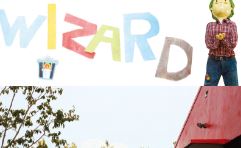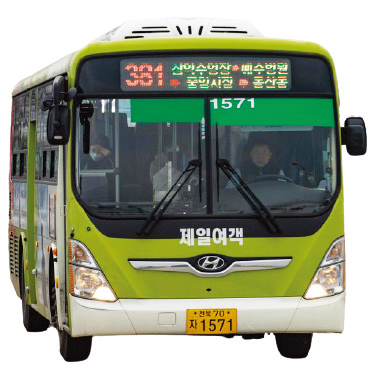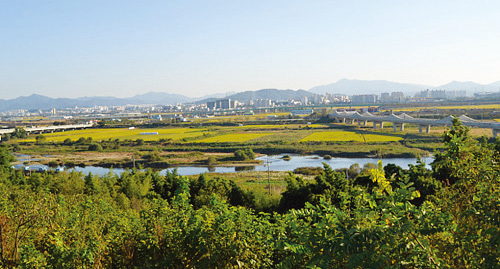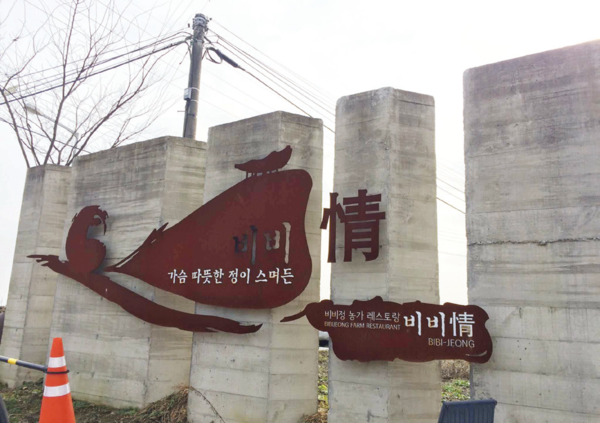Travel By No.381

Hello passengers. With the cool autumn breeze blowing, it has become a good season to travel. Even if you cannot go far due to COVID-19, how about taking a trip with the local city bus? In this issue of JBNU Globe, we will introduce some tourist attractions that can only be reached by city buses. Then, please fasten your seatbelts.
No. 381

No.381 is the route connecting Jeonju Vision University in Hyoja 4-dong, Jeonju to Wooseok University in Samryeeup, Wanju-gun. This route is one of the best bus routes for travelers to Jeonju, with it passing the beautiful tourist spots of JBNU and Gaeksa. On this route, travelers can enjoy both the city scenery of Jeonju and the quiet rural village of Samrye.
This Stop is Palbok Art Factory, Playground of Artists

In the Palbok Industrial Complex, there is a unique factory that does not produce products anymore. The name of the factory is Palbok Art Factory. Before it was the Palbok Art Factory, the SOREX cassette-tape factory was established here, in 1979. However, as the cassette-tape disappeared due to the emergence of CDs and MP3s in the digital era, it closed down in 1992. It was left as an abandoned building for 25 years after its closure. But in 2018, a project focussed on regenerating abandoned industrial facilities transformed the industrial complex into a cultural space named the Palbok Art Factory. As such, you can feel the history of this building in the exhibition halls, which numerous unsold tapes and workbooks that had piled up from when the factory closed down. Their 'Sunny' café, located next to the lobby also contains many interesting remnants of the past. At the entrance to the cafe for example, there is an artwork depicting a female warrior, assembling tapes in the factory. The old, iron door to the building has also now been transformed into a table at the cafe’. On the fi rst fl oor of Building A, there is a creative studio where artists can create their own artwork. Palbok Art Factory also selects a number of artists every year to receive their own creative space, accommodation for one year and also the opportunity to create their own exhibition at the center.
In the main exhibition hall, various uniquely themed exhibitions are held. And if you go out through the door on the southern side of the exhibition room, there are other artworks that represent the joy and sorrow of the factory workers. The toilets used by female workers in the past are preserved as they were then. There were only four toilets that 400 to 500 female workers could use. It clearly shows how poor the working environment was back then.
This Stop is Samrye Market, With History and ‘Insim’

In the past, Samrye Market was one of the major markets which supplied agricultural products to Jeonju. Since the Goryeo Dynasty, the market formed around Samrye Yeokwon (which refers to traffic, communication and accommodation that Installed to the busy traffi c routes), and as such, traditional markets started to develop. At the end of the Joseon Dynasty, these markets had a historical signifi cance as a place for the Donghak Peasant Movement.
Today Samrye Market itself is located in a densely populated part of the town. It is an active, permanent market, with a special, busier market held every 5 days. In Samrye, the special market occurs whenever there is a ‘3’ or an ‘8’ included in the date. Samrye Market will be a unique experience, where you can feel a lively and friendly traditional Korean market atmosphere and unique generosity of ‘Insim’.
This Stop is Bibijeong Village, with Sceneric View

Bibijeong Village is one of the eight scenic views of Wanju. It is here that you can experience sophisticated cultural and artistic sensibility along with the simplicity of the countryside. The name of Bibijeong village originated from ‘Bibijeong’, a historic pavilion near the village. The village boasts a beautiful view as Samryecheon Stream flows in front of the Bibijeong Pavilion and the vast Honam Plain spreads out in the background. Until 2009, Bibijeong village was the poorest village in Wanju. However, after some extensive renovation, the village has changed into a scenic tour spot. There are two places to visit when you tour Bibijeong Village.
The first place is the farmhouse restaurant ‘Bibi情(jeong)’. This restaurant only uses local food grown by local ma’ams in the village. You can enjoy healthy neat dishes cooked by ma’ams without any artificial seasonings. The second place is ‘Bibi Nagan café’. The café is located at the highest point in the village and retains a beautiful view.
Hello passengers. It is a pity, but we have now arrived at the end of our trip,of happiness. Through this trip, JBNU Globe hopes that you do not lose your laughter, even during these difficul times. See you in the next issue. Thank you.
Lee Won-jun Editor-in-chief

